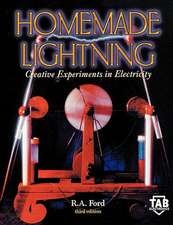Wafer Fabrication: Factory Performance and Analysis: The Springer International Series in Engineering and Computer Science, cartea 339
Autor Linda F. Atherton, Robert W. Athertonen Limba Engleză Hardback – 30 noi 1995
Din seria The Springer International Series in Engineering and Computer Science
- 24%
 Preț: 1041.98 lei
Preț: 1041.98 lei - 20%
 Preț: 643.50 lei
Preț: 643.50 lei - 18%
 Preț: 1225.62 lei
Preț: 1225.62 lei - 18%
 Preț: 965.02 lei
Preț: 965.02 lei - 20%
 Preț: 646.12 lei
Preț: 646.12 lei - 18%
 Preț: 948.79 lei
Preț: 948.79 lei - 20%
 Preț: 646.62 lei
Preț: 646.62 lei - 15%
 Preț: 637.46 lei
Preț: 637.46 lei - 20%
 Preț: 643.83 lei
Preț: 643.83 lei - 18%
 Preț: 949.23 lei
Preț: 949.23 lei - 20%
 Preț: 644.48 lei
Preț: 644.48 lei - 20%
 Preț: 994.92 lei
Preț: 994.92 lei - 20%
 Preț: 645.97 lei
Preț: 645.97 lei - 18%
 Preț: 946.87 lei
Preț: 946.87 lei - 20%
 Preț: 995.57 lei
Preț: 995.57 lei - 18%
 Preț: 956.99 lei
Preț: 956.99 lei - 20%
 Preț: 644.98 lei
Preț: 644.98 lei - 15%
 Preț: 649.54 lei
Preț: 649.54 lei - 18%
 Preț: 950.21 lei
Preț: 950.21 lei - 18%
 Preț: 1221.38 lei
Preț: 1221.38 lei - 18%
 Preț: 957.62 lei
Preț: 957.62 lei - 15%
 Preț: 643.99 lei
Preț: 643.99 lei - 18%
 Preț: 948.47 lei
Preț: 948.47 lei - 18%
 Preț: 947.35 lei
Preț: 947.35 lei - 20%
 Preț: 1284.65 lei
Preț: 1284.65 lei - 20%
 Preț: 1628.31 lei
Preț: 1628.31 lei - 20%
 Preț: 1285.78 lei
Preț: 1285.78 lei
Preț: 1232.26 lei
Preț vechi: 1502.76 lei
-18% Nou
Puncte Express: 1848
Preț estimativ în valută:
235.80€ • 252.14$ • 196.60£
235.80€ • 252.14$ • 196.60£
Carte tipărită la comandă
Livrare economică 18 aprilie-02 mai
Preluare comenzi: 021 569.72.76
Specificații
ISBN-13: 9780792396192
ISBN-10: 0792396197
Pagini: 468
Ilustrații: XX, 468 p.
Dimensiuni: 156 x 234 x 27 mm
Greutate: 0.86 kg
Ediția:1996
Editura: Springer Us
Colecția Springer
Seria The Springer International Series in Engineering and Computer Science
Locul publicării:New York, NY, United States
ISBN-10: 0792396197
Pagini: 468
Ilustrații: XX, 468 p.
Dimensiuni: 156 x 234 x 27 mm
Greutate: 0.86 kg
Ediția:1996
Editura: Springer Us
Colecția Springer
Seria The Springer International Series in Engineering and Computer Science
Locul publicării:New York, NY, United States
Public țintă
ResearchCuprins
1. Introduction to the Electronic Industry.- 1.0 Introduction.- 1.1 Wafer Fabrication.- 1.2 Wafer Fabrication Factories.- 1.3 Wafer Fabrication Equipment.- 1.4 Circuit Design to Wafer Fab: The Interface.- 1.5 Manufacturing Economics.- 1.6 Fab Performance Analysis.- 1.7 Methods of Performance Analysis.- 1.8 Archetypes of Wafer Fabs.- Further Reading and Notes.- References.- Exercises.- 2. Factory Phenomena.- 2.0 Introduction: Peeling the Onion.- 2.1 Fundamental Entities in Wafer Fabrication.- 2.2 Factory Dynamics.- 2.3 Yield and Process Control.- 2.4 Fallacies in Wafer Fabrication.- Further Reading and Notes.- References.- Exercises.- 3. Processes for Wafer Fabrication.- 3.0 Introduction.- 3.1 Semiconductor Process Technology.- 3.2 Multilevel Interconnect.- 3.3 The Chemical Reactors of Wafer Fabrication.- 3.4 Wafer Cleaning.- 3.5 Photoresist Processing.- 3.6 Plasma Etching.- 3.7 Other Processes.- 3.8 Summary.- Further Reading and Notes.- References.- Exercises.- 4. Fab Graphs and Static Analyses.- 4.0 Introduction.- 4.1 Factory Representation Using Fab Graphs.- 4.2 Drawing Fab Graphs.- 4.3 Fab Layout.- 4.4 Fab Flexibility.- 4.5 Rules of Thumb for Drawing Fab Graphs.- 4.6 Multiple Process Flows and Engineering Lots.- 4.7 Using Fab Graphs with Tracking Data.- 4.8 Static Capacity Planner.- Further Reading and Notes.- References.- Exercises.- 5. Factory Performance Basics.- 5.0 Introduction.- 5.1 Factory Performance Definitions.- 5.2 Inexorably-Bound Factory Performance Relationships.- 5.3 Operations Policy and Fab Performance.- 5.4 The Role of the Controlling Bottleneck.- 5.5 The Pros and Cons of Burst Capacity.- 5.6 Factory Performance Trade-offs.- 5.7 Summary.- Further Reading and Notes.- References.- Exercises.- 6. Advanced Performance Concepts.- 6.0 Introduction.- 6.1 Multiple Process Flows.- 6.2 Setup Rules.- 6.3 Batching Rules.- 6.4 Dispatching Rules.- 6.5 Engineering or Development Lots.- 6.6 Bottleneck and Capacity Estimator.- 6.7 Process Creep.- 6.8 Process Migration.- 6.9 Equipment Availability.- 6.10 Achieving Good Factory Performance.- Further Reading and Notes.- References.- Exercises.- 7. Factory Modeling.- 7.0 Introduction.- 7.1 Fab Graphs.- 7.2 Process/Equipment/Lot Interactions.- 7.3 Discrete Event Simulation.- 7.4 Lot Starts.- 7.5 Factory System Behavior.- 7.6 Fundamental Performance Analyses.- 7.7 Workstation Dynamics.- 7.8 Queueing Dynamics.- 7.9 Lot Dynamics.- 7.10 Lot Completions.- 7.11 Synthetic Experience.- 7.12 Sensitivity Analysis.- 7.13 Modeling Methods in General.- 7.14 Cluster Tool Modeling.- Further Reading and Notes.- References.- Exercises.- 8. Cluster Tools.- 8.0 Introduction.- 8.1 Mini-factories.- 8.2 Manufacturing Simplification.- 8.3 Types of Cluster Tools.- 8.4 Configuring Cluster Tools.- 8.5 System Dynamics.- 8.6 Clustering for Manufacturing Performance.- 8.7 Summary.- References.- Exercises.- Projects.- 9. Performance Economics.- 9.0 Introduction.- 9.1 Cost Allocation by Resource Consumption.- 9.2 Contributors to Wafer Cost.- 9.3 Wafer Costing and the Evolving Factory.- 9.4 Cost per Good Die.- 9.5 Summary.- Further Reading and Notes.- References.- Exercises.







